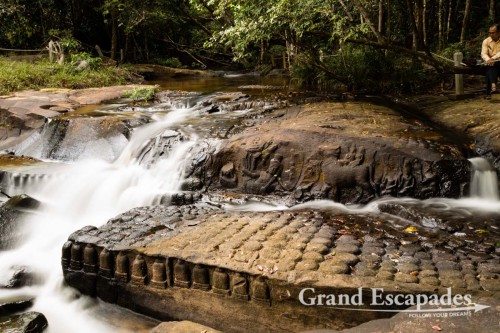A bit weary of temples? Head out to Kbal Spean, in the midst of the jungle, a 1.5 hour north of Siem Reap. The trip itself is scenic, since the road runs through a Cambodia as rural as it can be: rice paddies, villages with their characteristic stilt houses, lots of children walking to or from school, hardly any traffic…
Once you arrive at the parking lot, you need to walk for about 30 minutes through the rainforest. The path is well-marked and very pleasant. Again, this monument is NOT a temple, but consists of hundreds of carvings, found in the river bed, “The River of a Thousand Linga”. A linga is a phallic symbol of fertility, but these looked more like little disks to us. These were cut into the rock by hermits between the 11th and the 13th century in order to “fertilize” the waters that fed the rice paddies below.
During the rainy season, the river dries up and the carvings are viewed best then, whereas when the water is really high, they simply disappear. For our visit the level of water was perfect, the disks were just covered by a few centimeters of water and glittered in the sun. There are a few other carvings on rocks all around, which we found with the help of a young man. He waits at the top and for a small tip shows you around.
It is not the many disks that are so spectacular, but the whole setting in the jungle, the walk up and the trip from Siem Reap. A trip to Kbal Spean is best combined with a visit of Banteay Srei, another must-stop.
Banteay Srei, famous for its elaborate carvings, is a small temple on the way to Kbal Spean and a must stop. A first glance at the entrance area brought a pleasant deja vue. The same kind of pillars was leading up into the temple as at Wat Phu in Champasak in Laos. We were relieved to see that the monument was fairly compact, not as extensive as others.
Despite our enthusiasm, the heat was wearing us out. The most intricate carvings are found in the lintel above each doorway. The inner enclosure is also in exceptionally good condition. We found ourselves studying the carvings very closely with mythical figures, animals, swirls etc…
Since the site is so small, you get a good overall view of the entire inner enclosure with its little towered shrines from relatively close up. With low surrounding walls, the temple itself is quite a sight. It is sagging in or tilted at some places, but still standing after more than 1.000 years.
Banteay Srei is so remote that it was only discovered in 1914! We were glad to see that a good number of visitors come out here to pay tribute to this magnificent sight.


No comments yet.